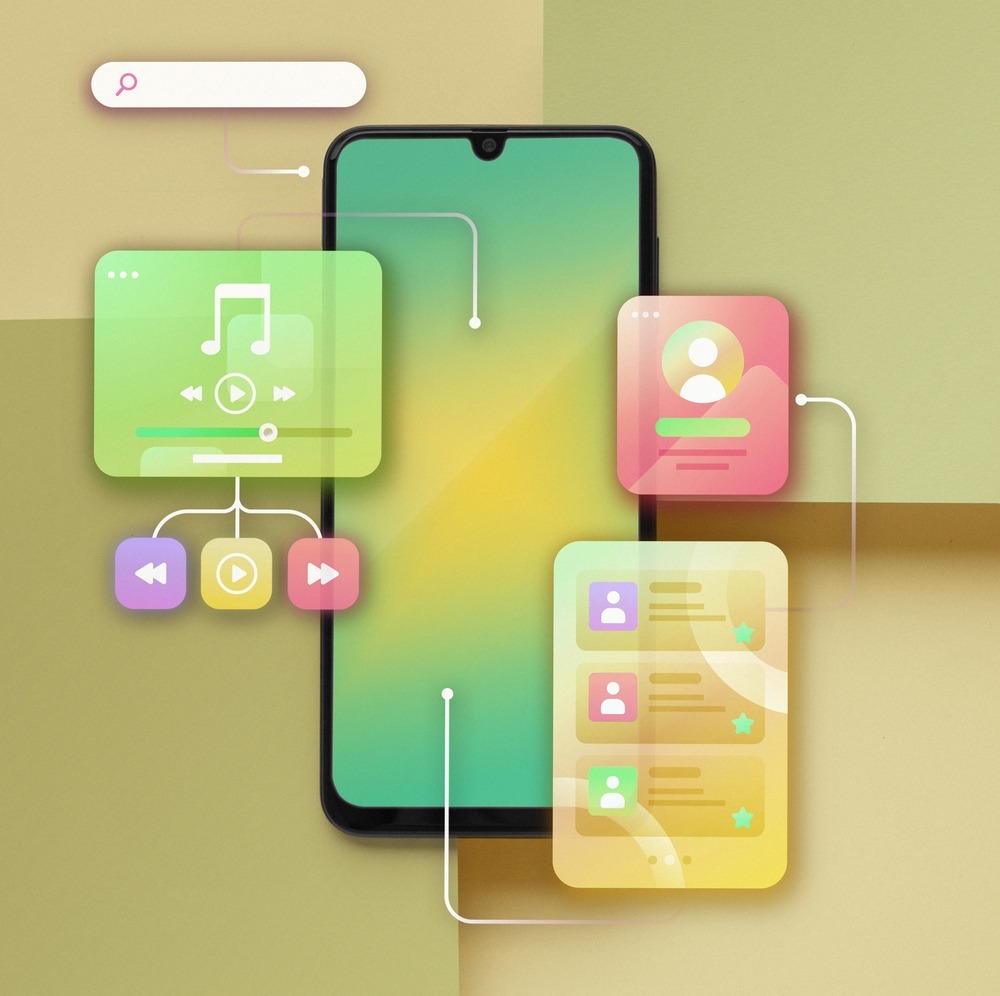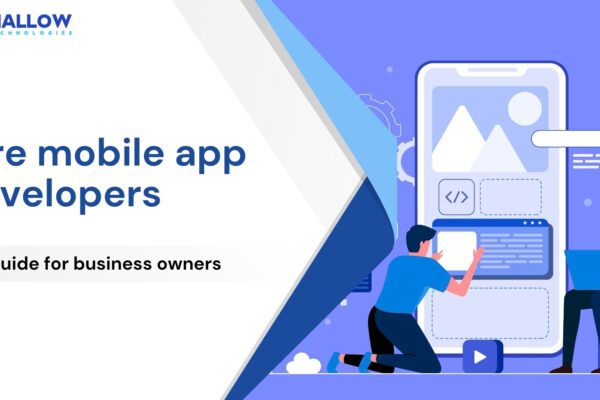Is your iOS application suffering from sluggish load times, longer rendering durations, and behaves abnormally many times? Are you struggling to ensure device-specific support for low-end configurations while keeping memory usage, battery consumption, and data consumption in check? Do you find it challenging to maintain the stability of your app under various usage scenarios?
If these questions resonate with your experience, you’re not alone. In today’s fiercely competitive digital landscape, iOS application performance can make or break your business success.
At Mallow, we’ve successfully partnered with clients globally, gaining valuable insights into diverse business challenges. Our commitment to excellence and informed decision-making has been key to our success in delivering top-notch solutions. This extensive background uniquely equips Mallow to offer valuable insights and strategies for enhancing iOS application performance to drive your business to new heights.
After going through this article, we’ll cover what can make your iOS application perform poorly and where you should focus to make improvements. By focusing on these areas, you will learn how to address common pain points, ensure the stability of your applications, and manage memory, battery, and data consumption effectively.
What degrades the performance of your iOS application?
Applications have become an integral part of our daily lives, and their performance plays a pivotal role in user satisfaction and business success. The performance of an iOS application is a critical factor that directly impacts user satisfaction and the success of your business.

Understanding the key factors that can degrade your app’s performance is the first step in optimising it for a seamless user experience. Your company’s goodwill is intricately tied to how well your application performs and how intuitively it provides a better user experience. After all, an application that runs smoothly, conserves battery, and efficiently manages data not only retains users but also attracts new ones, ultimately contributing to the prosperity and reputation of your business.
Here are the aspects that can undermine the performance of your iOS application:
Random crashes
Random crashes are a significant threat to an iOS application’s performance and user satisfaction. When users encounter frequent crashes, their trust in the app diminishes, and they are more likely to seek alternatives. App stability is paramount, and to achieve it, rigorous testing, crash monitoring, and proactive bug fixing are essential. Regular updates and addressing crash reports promptly can help maintain a stable application that keeps users engaged and satisfied.
Battery consumption
Excessive battery consumption is a common frustration for mobile device users. An app that rapidly drains the battery not only leads to user dissatisfaction but can also result in uninstalls. To optimise battery consumption, developers should minimise background processes, resource-intensive tasks, and unnecessary background activity. By ensuring that an app is energy-efficient, it can extend the device’s battery life and provide a more reliable user experience.
Data usage
In a world of capped data plans, excessive data usage by an app can lead to increased costs for users and reduce the app’s appeal. To prevent this, developers must optimise their app’s data usage by employing caching, efficient data loading, and minimising unnecessary data transfers. Prioritising data efficiency ensures users enjoy the app without exceeding their data limits or incurring unexpected charges.
Memory management
Inefficient memory management can lead to performance bottlenecks and app crashes. Proper memory allocation, efficient resource utilisation, and timely deallocating unused memory are crucial for maintaining a responsive app. By monitoring memory usage, identifying memory leaks, and optimising the allocation of resources, developers can prevent memory-related performance issues and deliver a seamless user experience.
UI responsiveness
A smooth and responsive user interface is vital for user satisfaction. UI lag or unresponsiveness can deter users from engaging with an app. Achieving optimal UI responsiveness involves techniques like optimising layout rendering, reducing image sizes, running the heavy-performance tasks either asynchronously or in background and minimising the congestion of the UI thread. By addressing these aspects, developers can ensure that the app’s interface remains snappy and user-friendly.
Integrating third-party services
Integrating third-party services can enhance an app’s functionality, but it can also introduce performance bottlenecks if not managed correctly. Ensuring that these integrations are thoroughly tested, properly optimised, and designed for efficient data exchange is critical. Developers should also implement proper error handling and redundancy strategies to ensure the app remains stable even when relying on external services. Careful management of third-party integrations is key to preventing performance degradation and maintaining a positive user experience.
Where should you focus when optimising your iOS application’s performance?

Code efficiency
Efficient code is the foundation of a high-performing iOS application. The app’s architecture plays a crucial role in this regard. It’s essential to review and refine your app’s architecture to ensure it can handle tasks efficiently. Consider optimising background tasks to run seamlessly without impacting the foreground user experience.
To achieve this, adopt best practices in coding, utilise background thread management, and implement asynchronous operations where necessary. Focusing on efficient code not only enhances your app’s performance but also ensures that it operates smoothly and responsively, leading to greater user satisfaction.
Your action items typically involve:
✅ Utilise Swift’s value types and structures where applicable to reduce memory overhead.
✅ Employ background tasks and DispatchQueue to offload resource-intensive operations from the main thread.
✅ Implement intelligent caching strategies for frequently accessed data, considering Cache for in-memory caching and UserDefaults for lightweight data storage.
✅ Use Swift-specific performance optimisations, like lazy property initialisation and optionals, to reduce resource consumption.
✅ Ensure the app leverages Swift’s error-handling mechanisms (try, catch) to gracefully handle exceptions and avoid crashes.
Performance tuning from the API side
How well your iOS app runs doesn’t just rely on what’s happening on the phone or tablet. The way the backend works is just as important for its performance.To ensure your backend supports your app’s requirements, conduct a thorough assessment of its efficiency.
Referring to resources related to Ruby on Rails (RoR) and Laravel, popular backend development frameworks, can provide valuable insights into performance tuning techniques. Examine database queries, API endpoints, and server responses. Optimise the server to respond swiftly to client requests, thereby reducing latency and enhancing the overall app performance.
Your action items typically involve:
✅ Optimise API calls by using iOS-specific frameworks like Alamofire for efficient network requests.
✅ Implement URLSession for network communication, using its background session capabilities and ability to prioritise tasks.
✅ Leverage Apple’s Core Data framework for efficient local data storage and synchronisation with a server.
✅ Implement URLCache and HTTP caching to reduce network requests and improve data retrieval efficiency.
✅ Ensure that your app’s data serialisation and deserialisation processes are optimised for JSON data through JSONEncoder and JSONDecoder.
✅ For enhancing performance of your application, make sure that your application’s backend has indexed database, optimised queries and has effectively implemented caching.
✅ Check whether your backend system has enough capacity of servers to handle the expected traffic.
✅ Ensure that your backend has distributed the load effectively for smooth running of your application without slowing down the application during traffic surges.
✅ Configure application monitoring tools with your application, so as you can take the right action at the right time, protecting your brand’s goodwill.
Check out the articles on how to speed up the performance of your Laravel application or how can you improve the performance of your Ruby on Rails application, to know more details about how you can speed up the performance of your application based on the concerned backend tech stack you have used for your application.
Memory management
Effective memory management is pivotal for preventing your iOS app from becoming sluggish, and unresponsive. To improve memory management, analyse your app’s memory consumption and address memory leaks. Adopt practices like releasing objects no longer in use, optimising data structures, and utilising efficient data caching mechanisms. Memory-efficient coding ensures that your app operates smoothly, preventing crashes due to memory exhaustion and enhancing the user experience.
Your action items typically involve:
✅ Apply Swift-specific memory management techniques, such as weak and unowned references, to prevent retain cycles.
✅ Monitor memory usage using Instrumentation tool provide by Apple and identify areas where Swift-specific memory leaks or retain cycles occur.
✅ Implement lazy property initialisation to defer memory allocation until the data is actually needed.
✅ Apply Swift-specific memory management patterns, like ARC (Automatic Reference Counting), to control object lifecycles and release unused resources.
Image and asset optimisation
Images and assets constitute a significant portion of an app’s size and directly impact its performance. Optimising these assets can lead to faster load times and reduced data consumption. To optimise images and assets, consider using modern image formats such as WebP, SVG, or JPEG 2000, a scalable pdf image and compress them without compromising quality. Implement optimised asset loading to load only the assets needed at a specific time, reducing memory usage and data consumption, and resulting in a more responsive app.
Your action items typically involve:
✅ Utilise iOS-specific image asset management through Asset Catalogs for easy management of various image sizes and resolutions.
✅ Compress and optimise image assets using Xcode’s asset slicing and ImageOptim to reduce app bundle size.
✅Implement On-Demand Resources to load assets as needed and reduce the initial app download size.
✅ Optimise image loading using iOS-specific libraries like SDWebImage or Kingfisher for efficient remote image caching and loading.
✅ Leverage Apple’s UIImage asset caching to manage memory efficiently when handling images in your app.
Database performance
Database performance is often a bottleneck in app responsiveness. To address this, fine-tune your database queries to execute more efficiently. Use indexing to speed up data retrieval and caching to store frequently accessed data, reducing the need for repeated queries. By optimising database performance, you can significantly enhance your app’s response times and ensure a smoother user experience.
Your action items typically involve:
✅ Optimise data storage using Core Data with SQLite as the backend for efficient local data management.
✅ FetchRequests allows you to specify precisely which data you want from the database. This means that only relevant data is fetched, reducing the time and resources required for data retrieval.
✅ Implement FetchedResultsController to efficiently fetch and display data from Core Data in UITableViews and UICollectionViews.
✅ Batch process the data, ensuring that you retrieve and process data in manageable chunks rather than loading the entire dataset into memory at once. Make sure that you follow the batch operations for bulk inserts, create, update and delete operations.
✅ Use saveContext judiciously, only when necessary, to avoid unnecessary database writes and optimise the performance of your application.
✅ Utilise Apple’s CloudKit framework for scalable and efficient cloud-based database synchronisation.
✅ Monitor database performance using Instruments and Core Data-specific diagnostics to identify and resolve performance bottlenecks.
UI Responsiveness
A responsive user interface is crucial for user satisfaction. To improve UI responsiveness, consider implementing lazy loading of UI components. This approach loads UI elements only when they become visible to the user, reducing the initial load time and conserving memory. Additionally, optimise animations and transitions to ensure they run smoothly, enhancing the overall user experience.
Your action items typically involve:
✅ Implement lazy loading of UI components to load them only when they become visible to the user, using techniques like UITableView’s dequeueReusableCellWithIdentifier.
✅ Optimise animations and transitions using Core Animation to take full advantage of iOS’s animation capabilities.
✅ Minimise UI blocking by running time-consuming tasks in the background with Grand Central Dispatch (GCD) or OperationQueue.
✅ While using Auto Layout, make sure to give the constraints properties correctly in storyboard. You can also use SwiftUI but here you need to make sure that the constraints given in the code is provided correctly. In both the cases, the main purpose is to ensure the design is intuitive to varios iOS devices and orientations.
✅ Continuously gather user feedback and monitor user interactions through analytics tools like Hotjar to identify UI responsiveness and other interaction-related issues and address them promptly.
Updates and compatibility
Staying up to date with the latest iOS versions and ensuring compatibility with new hardware and software features is essential. Regularly update your app to take advantage of new APIs, features, and performance improvements introduced by Apple. By staying current, you can provide a better user experience, address compatibility issues, and maintain a competitive edge in the market.
Your action items typically involve:
✅ Regularly update the app to support the latest iOS versions, including major and minor releases, and adopt new APIs introduced in those versions.
✅ Ensure compatibility with new hardware features, screen sizes, and resolutions by testing on different iOS devices.
✅ Adhere to Apple’s guidelines and best practices, such as the Human Interface Guidelines, to maintain compatibility and compliance with App Store requirements.
✅ Continuously review and adapt your app’s features and interface to leverage new iOS capabilities, such as widgets, ARKit, or Core ML.
✅ Maintain a feedback loop with users to gather input on compatibility issues and address them in future updates, using App Store Connect to collect user feedback.
Configure error monitoring tools
Effective error monitoring tools are indispensable for iOS applications, as they continuously monitor the app’s performance, track crashes, and pinpoint issues in real-time. By furnishing you with valuable insights, these tools enable you to identify issues effectively, using which you can address them immediately, ensuring a seamless user experience. They not only save valuable time in diagnosing and addressing errors but also contribute to overall app quality, stability, and user satisfaction, making them an essential component of any iOS app development and maintenance strategy.
Your action items typically involve:
✅ Choose an error monitoring tool that suits your application’s needs. Consider factors like platform compatibility, ease of integration, and the tool’s capabilities.
✅ Configure alerting and notification settings to receive timely updates about critical issues. Set thresholds for the severity of alerts.
✅ Ensure that the tool integrates with your preferred logging and debugging tools, making it easier to trace and resolve issues.
✅ If your application requires user authentication, make sure the error monitoring tool can identify users by unique identifiers or email addresses for tracking user-specific issues.
✅ Once you resolve the error that you were notified about, you need to release the new version with the necessary changes being attended to provide a hassle-free experience to your application user.
Network performance
Network performance impacts both data usage and app responsiveness. To improve network performance, minimise data usage by using efficient data transfer protocols and optimising the size of network requests and responses. Implement caching to reduce the number of network requests, which can lead to faster loading times and a more responsive app.
Your action items typically involve:
✅ Minimise data usage by using efficient data transfer protocols such as Apple’s URLSession and pass on only the information that is necessary.
✅ You can also use “Combine” framework in SwiftUI to handle asynchronous tasks efficiently. This will also be more helpful while dealing with notifications, timers, SuccessBlocks and CallBacks.
✅ Compress network requests and responses by utilising RxSwift zip, when dealing with JSON or text-based data.
✅ Implement local caching using Apple’s URLCache for frequently used data to reduce network requests and leverage response caching headers.
✅ Monitor and optimise the frequency and volume of network requests made by the app, adhering to the Background Modes capabilities for efficient background fetching.
✅ Continuously monitor network performance and address latency issues by optimising server response times and network efficiency, emphasising App Transport Security (ATS) configuration for secure and efficient connections.
Battery performance
Optimising battery performance is vital for maintaining user trust and ensuring long-term app usage. Implement strategies to minimise background activities that drain the device’s battery. Use efficient power management techniques, such as scheduling tasks during periods of low activity, to enhance battery life and extend the usability of your app.
Your action items typically involve:
✅ Implement efficient power management strategies using background execution modes, allowing the system to optimise task scheduling during periods of low device activity.
✅ Monitor the app’s battery consumption by utilising Apple’s Energy Usage tool in Instruments and optimise power-hungry features or background processes accordingly.
✅ Provide user settings to control power-intensive features, such as background refresh or location services, accessible through the Settings app or in-app settings screens.
✅ Regularly test and profile the app for battery drain using Instruments’ Energy Diagnostics instruments and identify areas where improvements can be made.
Testing and profiling
Regular testing and profiling are essential for identifying and addressing performance issues. Continuously test your app under various conditions, including different devices and network conditions, to uncover potential bottlenecks. Utilise profiling tools to pinpoint areas that require optimisation. Profiling helps you understand which parts of your app are consuming excessive resources and guides your optimisation efforts effectively.
Your action items typically involve:
✅ Conduct regular testing under various iOS versions, device types, and screen sizes to identify compatibility issues and performance variations.
✅ Utilize XCTest and XCUITest for unit and UI testing, respectively, to ensure the app functions correctly and maintains a smooth user experience.
✅ Implement performance testing using Apple’s Instruments tool to analyse CPU, memory, and energy consumption during various app scenarios.
✅ Profile your app using Instruments, focusing on Energy Diagnostics, Time Profiler, and Leaks instruments to identify performance bottlenecks and memory leaks.
✅ Implement performance testing using Apple’s Instruments tool to analyse CPU, Time Profiler, Memory leaks, and energy consumption during various app scenarios.
✅ Leverage Accessibility Inspector to test your app’s accessibility features and ensure compliance with accessibility standards, benefiting all users.
How to ensure the security of your iOS application from the backend
At this point, you should have a comprehensive understanding of the factors that can negatively impact the performance of your iOS application and the underlying reasons behind these performance issues. Additionally, you are now well-informed about the crucial areas that require your focus and the specific actions you need to take in each area for performance optimisation.

Ensuring the security of your iOS application from the backend is a top priority, serving as the initial safeguard against potential threats and vulnerabilities that might jeopardise user data and the integrity of your application. The implementation of robust security measures encompasses rigorous server-side practices, including but not limited to data encryption, user authentication, and input validation.
Implementing proper access controls, employing security protocols like OAuth 2.0 for user authentication, and conducting regular security audits are vital steps to safeguard your iOS application and the sensitive information it manages.
Check out the articles on how to ensure the security of your Ruby on Rails application or how to ensure your Laravel application is safe from common security attacks for detailed insights. These resources can guide you in securing your server, ensuring safe data transmission, protecting against SQL injection and other common attacks, and keeping your users’ data confidential.
Still confused about your next step? Feel free to reach out to our team.
Your queries, our answers
Mobile application development involves creating software applications designed to run on mobile devices like smartphones and tablets. These apps can be native (built specifically for iOS or Android), cross-platform (designed to work on multiple platforms), or hybrid (combining elements of both).
Our mobile app development process includes the following stages: requirement gathering and analysis, design and prototyping, development and coding, testing and quality assurance, deployment, and post-launch support. Each stage is crucial to delivering a high-quality application.
To gain deeper insights into the experience of working on a mobile project with Mallow, explore more details here.
The choice between native and cross-platform development depends on your project’s goals, budget, and target audience. Native apps offer better performance and a more tailored user experience, while cross-platform apps allow for faster development and lower costs by using a single codebase for multiple platforms. For a detailed comparison of Native vs. Hybrid development, explore our comprehensive analysis to help you make an informed choice.
Mallow develops mobile apps for iOS, Android, and cross-platform solutions. We use the latest technologies and frameworks to ensure your app performs optimally on the platforms that matter most to your users.
Choosing the right features for your mobile app depends on understanding your target audience, business goals, and budget. We work closely with you to prioritize features that will provide the most value to your users and align with your business objectives.
At Mallow, we offer ongoing app maintenance and updates as part of our post-launch services. This includes regular updates to improve performance, add new features, and ensure compatibility with the latest operating systems. For more details, get in touch with our team.
Yes, Mallow assists with the entire app store submission process, including meeting the guidelines for Apple’s App Store and Google Play. We ensure your app is ready for submission and provide support to help it get approved.
Mallow uses a variety of technologies and frameworks for mobile app development, including Swift and Objective-C for iOS, Kotlin and Java for Android, and React Native and Flutter for cross-platform development. Our technology choices are driven by the specific needs of your project.
Our testing process includes functional testing, performance testing, security testing, usability testing, and compatibility testing across different devices and operating systems. We ensure your app is bug-free and performs optimally before it goes live.
The cost of developing a mobile app depends on several factors, including the app’s complexity, features, platform (iOS, Android, or both), and the development team’s expertise. Costs can range from $10,000 to $150,000 or more. To know more, check out how much it costs to work on a mobile project with us.
The development timeline for a mobile app varies depending on the complexity of the project. A basic app may take 2-4 months to develop, while a more complex app with advanced features can take 6-12 months or longer.
Choosing the right features for your mobile app depends on understanding your target audience, business goals, and budget. We work closely with you to prioritize features that will provide the most value to your users and align with your business objectives.
Yes, Mallow offers comprehensive post-launch support, including monitoring, updates, bug fixes, and enhancements. We ensure your app remains up-to-date and continues to perform well after it’s launched.
A mobile app can enhance customer engagement, increase brand visibility, provide better service through personalized experiences, and create new revenue streams. It also allows you to reach a broader audience by making your services more accessible on mobile devices.
Getting started with Mallow is easy! Simply reach out to us to discuss your project. We’ll work with you to understand your goals, define your requirements, and create a development plan that meets your needs. Let’s bring your mobile app idea to life!.
Security is a top priority at Mallow. We implement advanced security measures, including encryption, secure authentication, and regular security audits, to protect your app from potential threats and ensure data integrity.
To learn more about how we handle and implement these security measures, check out more details here.
Author
Yogesh Murugesh
Yogesh is an accomplished Senior Technical Lead at Mallow, boasting over 11 years of invaluable expertise in the realm of application development. With an extensive background spanning diverse domains, he has consistently delivered applications of the highest calibre. Yogesh's commitment to quality and excellence shines through in every project he undertakes. His career journey is marked by a proven track record of successfully crafting applications that not only meet but often exceed industry standards. His ability to navigate through various domains showcases his adaptability and keen problem-solving skills. Yogesh's contributions have consistently played a pivotal role in driving technological innovation and advancement within his field. Beyond his professional pursuits, Yogesh finds solace and joy in various activities. An ardent cricket enthusiast, he embraces the team spirit and strategic thinking that the sport demands. During leisure moments, he indulges in watching movies, allowing himself to be captivated by different narratives and genres. Moreover, Yogesh cherishes quality time with his child, relishing the role of a devoted parent.



